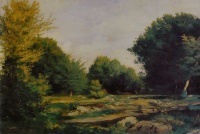Pierre-Auguste Renoir
From The Art and Popular Culture Encyclopedia
| Revision as of 12:45, 15 September 2007 Jahsonic (Talk | contribs) ← Previous diff |
Current revision Jahsonic (Talk | contribs) |
||
| Line 1: | Line 1: | ||
| - | {{Template}}'''Pierre-Auguste Renoir''' ([[February 25]], [[1841]]–[[December 3]], [[1919]]) was a French [[artist]] who was a leading [[painter]] in the development of the [[Impressionism|Impressionist]] style. As a celebrator of beauty, and especially feminine sensuality, it has been said that "Renoir is the final representative of a tradition which runs directly from [[Peter Paul Rubens|Rubens]] to [[Watteau]]". He was the father of filmmaker [[Jean Renoir]]. | + | {| class="toccolours" style="float: left; margin-left: 1em; margin-right: 2em; font-size: 85%; background:#c6dbf7; color:black; width:30em; max-width: 40%;" cellspacing="5" |
| + | | style="text-align: left;" | | ||
| + | "Having assimilated this new influence [[Pierre-Auguste Renoir |Renoir]] added it to his own store of knowledge, and four years later painted his greatest picture, ''[[Le Petit Peintre]]''. After this there was little more to be done in Renoir’s style unless he extended his vision to greater surfaces. This he has not done. But he has added other masterpieces to the ones already mentioned. His ''[[Ode aux Fleurs (d’après Anacréon)]]'', the two decorative Panneaux of the tambourine player and the dancer, ''[[Coco et les Deux Servantes]]'', ''[[La Rose dans les Cheveux]]'' and ''[[La Femme au Miroir]]'' are all worthy of a place beside the greatest pictures of all time."--''[[Modern Painting: Its Tendency and Meaning]]'' (1915) by Willard Huntington Wright | ||
| + | |||
| + | |} | ||
| + | [[Image:A Clearing in the Woods.jpg|thumb|right|200px|''[[A Clearing in the Woods]]'' (1865) by Pierre-Auguste Renoir]] | ||
| + | {{Template}} | ||
| + | |||
| + | '''Pierre-Auguste Renoir''' (25 February 1841 – 3 December 1919) was a [[French painter]] working in the [[Impressionism|Impressionist]] style. | ||
| + | |||
| + | He was the father of filmmaker [[Jean Renoir]] (1894–1979). | ||
| + | |||
| + | He is known for such paintings as ''[[A Clearing in the Woods]]'' (1865), ''[[Bal du moulin de la Galette]]'' (1876), ''[[Luncheon of the Boating Party]]'' (1881) and ''[[The Bathers (Renoir)|The Bathers]]'' (1918–19). | ||
| + | |||
| + | ==See also== | ||
| + | *[[History of painting]] | ||
| + | *[[Western painting]] | ||
| + | |||
| {{GFDL}} | {{GFDL}} | ||
Current revision
|
"Having assimilated this new influence Renoir added it to his own store of knowledge, and four years later painted his greatest picture, Le Petit Peintre. After this there was little more to be done in Renoir’s style unless he extended his vision to greater surfaces. This he has not done. But he has added other masterpieces to the ones already mentioned. His Ode aux Fleurs (d’après Anacréon), the two decorative Panneaux of the tambourine player and the dancer, Coco et les Deux Servantes, La Rose dans les Cheveux and La Femme au Miroir are all worthy of a place beside the greatest pictures of all time."--Modern Painting: Its Tendency and Meaning (1915) by Willard Huntington Wright |

|
Related e |
|
Featured: |
Pierre-Auguste Renoir (25 February 1841 – 3 December 1919) was a French painter working in the Impressionist style.
He was the father of filmmaker Jean Renoir (1894–1979).
He is known for such paintings as A Clearing in the Woods (1865), Bal du moulin de la Galette (1876), Luncheon of the Boating Party (1881) and The Bathers (1918–19).
See also

